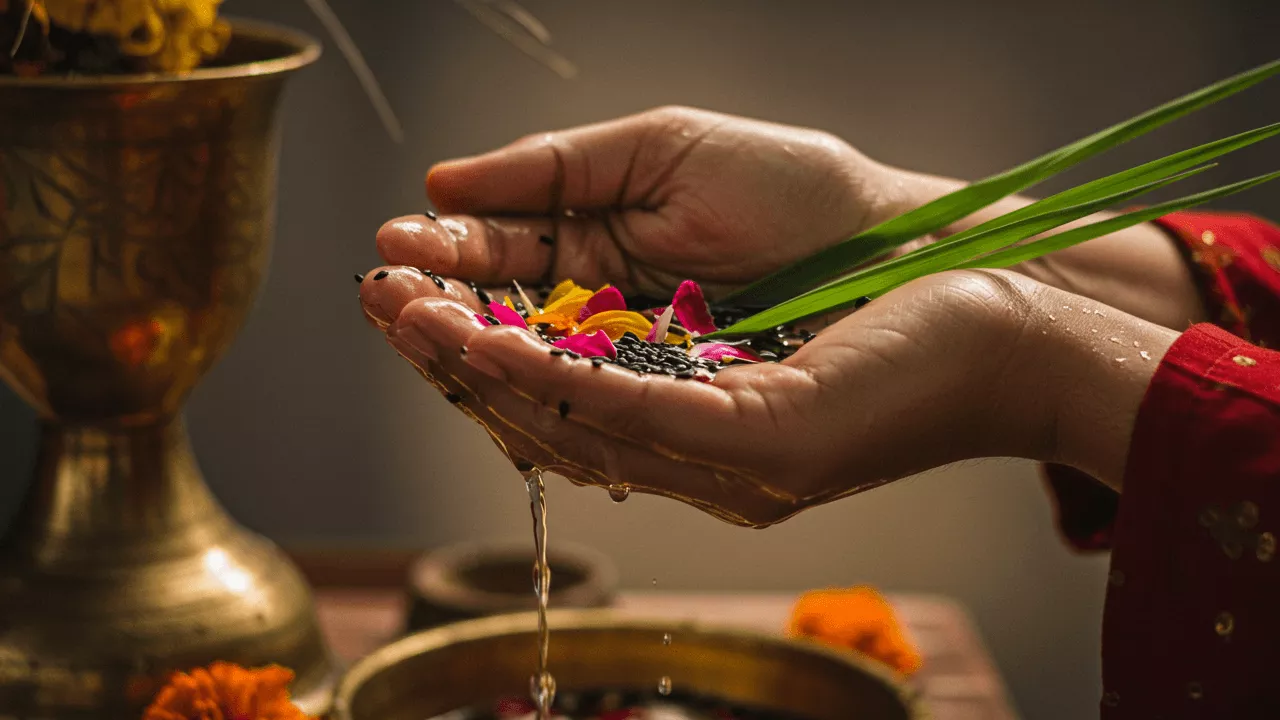Namaste,
This is like asking where a vital organ resides within the body – Tarpan is indeed distinct, yet fundamentally integrated into the complete well-being of the Shradh ceremony.
Pitrupaksha seasons unfold upon this sacred soil of Bharat, guided by the eternal wisdom radiating from our Puranas, allow me to illuminate the relationship between these two essential practices. Understanding this connection deepens our appreciation for the profound ways our ancestors devised to honour those who came before us.
Where Does Tarpan Fit? Unpacking the Vital Tarpan Role in Shradh Ceremonies
To grasp the Tarpan role in Shradh, we must first understand each term clearly. Often, these terms are used loosely, but they represent different facets of our ancestral duties (Pitṛ Karma).

What is Shradh (श्राद्ध)? The Complete Ancestral Homage
Shradh is the overarching term for the comprehensive set of rituals performed with Shradh(faith, sincerity, devotion) to honour and nourish our departed ancestors (Pitṛs). It is a multifaceted ceremony, a sacred duty (dharma), and an expression of profound gratitude (kṛtajñatā). A full Shradh ceremony, especially one like the Pārvaṇa Shradh performed during Pitrupaksha or on specific tithis (death anniversaries), typically involves several key components:
- Āvāhana: Invocation of the Pitṛs and associated deities (like the Viśvedevas).
- Pūjana: Worship offered to the invited Brahmins (who represent the Pitṛs) and the deities.
- Homa/Agni Karaṇa: Offerings made into the sacred fire.
- Piṇḍa Dāna: The offering of Piṇḍas (balls made typically of cooked rice, barley flour, mixed with ghee, honey, and black sesame seeds) – considered the most substantial food offering for the ancestors.
- Tarpan: Offering of water libations.
- Brāhmaṇa Bhojana: Feeding the invited, qualified Brahmins.
- Dāna: Offering gifts (like clothes, grains, money – dakṣiṇā) to the Brahmins and charity to the needy in the name of the ancestors.
- Svasti Vācana & Visarjana: Concluding prayers for well-being and respectfully bidding farewell to the invoked beings.
Shradh, therefore, is the complete package, the entire framework designed to satisfy the Pitṛs on multiple levels – subtle thirst, hunger, respect, and karmic merit.
What is Tarpan (तर्पण)? The Offering of Libations
Tarpan, as we have discussed before, literally means “to satisfy” or “to please.” It specifically refers to the ritual act of offering libations, primarily of water, often mixed with other sacred ingredients like black sesame seeds (kala til) or Kusha grass (darbha).
While Pitru Tarpan (offerings to ancestors) is our primary focus, the act of Tarpan is often extended to include offerings to:
- Devas (Gods): Acknowledging the divine forces governing the cosmos.
- Rishis (Sages): Honouring the ancient seers who received and transmitted Vedic wisdom.
- Pitṛs (Ancestors): Providing subtle sustenance and expressing reverence to the lineage.
- Sometimes, even Divya Manuṣya (divine humans) or other beings.
Tarpan addresses the subtle “thirst” of these beings and establishes a connection through the purifying medium of water.
Tarpan’s Crucial Role Within the Shradh Ceremony: Puranic Insights
Now, let’s connect the two. Tarpan is not separate from Shradh; rather, it is an essential and integral component of a complete Shradh ceremony. Its specific Tarpan role in Shradh is multifaceted, as highlighted by various Puranic injunctions:
1. Propitiating Gods and Manes (Garuda Purana)
The Garuda Purana explicitly clarifies the purpose of Tarpan within a larger ritual context, stating it serves to propitiate both the gods and the manes (Pitṛs). This highlights that within Shradh, Tarpan isn’t only for ancestors; it often includes preliminary offerings to Devas and Rishis, setting the stage and acknowledging the entire cosmic hierarchy before focusing intensely on the Pitṛs. This situates Tarpan as a bridge, connecting different realms within the Shradh framework.
2. Distinct Offering Method (Brahma Purana)
The Brahma Purana provides details that distinguish Tarpan from other key Shradh elements, solidifying its unique role.
- Hand Usage: It notes that Tarpan is performed using both hands joined to offer the water libation. This contrasts distinctly with the offering of the Pinda, which it implies (and tradition confirms) is typically done with a single hand (usually the right). This procedural difference underscores that Tarpan and Pinda Daan are separate, specific actions within the Shradh sequence, each with its own prescribed method.
- Invocation during Tarpan: The instruction to repeat the ancestor’s name and Gotra followed by “Tṛpyatām” during the water offering firmly places this invocation within the Tarpan phase itself.
- Caution on Sesame Use: The strong warning against improper use of sesame seeds during Tarpan (equating misuse to offering flesh and blood) emphasizes the ritual precision required specifically for this libation phase within the larger Shradh.
3. Specific Ingredients & Postures for Different Beings (Linga Purana)
The Linga Purana further details the nuances of Tarpan within the Shradh, showing how this single rite adapts based on the recipient:
- Varied Mixtures: Water with flowers for Devas, water with Kusha grass for Rishis, and water with gingelly seeds (sesame) for Pitṛs (with scents added for all). This detailed instruction clearly shows Tarpan is not monolithic; its execution varies depending on whom it’s offered to during the Shradh.
- Varied Sacred Thread Positions: The Purana mandates different Yajnopavīta positions for Tarpan to each category: Upavīta (normal, over left shoulder) for Devas, Nivīta (like a garland) for Rishis, and Prācīnāvīta (over right shoulder) for Pitṛs. This precise choreography of the sacred thread during the Tarpan phase highlights it as a distinct ritual segment with its own specific rules, enacted as part of the Shradh.
4. Association with Gotra & Purity (Skanda Purana)
The Skanda Purana contributes further context:
- Gotra Mention: Stating that the word ‘Gotre‘ (referring to lineage/clan) is uttered during the Tarpan rite confirms its role in identifying and honouring specific ancestral lines within the Shradh.
- Yajnopavīta Nuances: It reiterates the different sacred thread positions (Nivīta for humans/sages, Prācīnāvīta for Pitṛs) specifically during Tarpan, reinforcing its distinct procedural rules.
- Purity Context: The Skanda Purana’s strong emphasis on multi-faceted purity (body, articles, wife, ground, mind, mantra, Brahmins) during Shradh inherently applies to the Tarpan segment performed within it. The sanctity required for the overall Shradh naturally permeates the Tarpan offering.
5. Implied Integration (Varaha Purana)
While the Varaha Purana extensively details the broader Shradh ceremony (origins, types, Brahmin qualifications, food offerings), its discussions implicitly include Tarpan as a standard component of these ancestral rites. When it speaks of satisfying the manes, the offering of water libations is generally understood to be a fundamental part of that process.
Pinpointing the Sequence: Where Does Tarpan Occur in Shradh?

While Tarpan is integral, its exact placement within the sequence of a full Shradh ceremony can sometimes vary based on:
- Type of Shradh: A daily Nitya Shradh might involve simpler Tarpan, whereas a Pārvaṇa Shradh (performed on Amavasya or during Pitrupaksha) follows a more elaborate sequence.
- Family/Regional Tradition (Sampradāya): Different schools and family lineages might have slight variations in the order of rites.
- Specific Ritual Context: As the Garuda Purana reference concerning a consecration ceremony suggests, Tarpan might occur at specific junctures (like before a final oblation) depending on the overall ritual’s purpose.
However, some common placements for Tarpan within a standard Pārvaṇa Shradh include:
- Preliminary Rites: Often, Tarpan to Devas and Rishis is performed early in the ceremony, after initial purification (śuddhi) and invocation (āvāhana), before the main focus shifts entirely to the Pitṛs.
- Alongside/Following Pinda Daan: Pitru Tarpan (specifically for ancestors) is frequently performed either just before, during the process of, or immediately following the Pinda Daan. Sometimes, water is offered onto the Pindas themselves, or Tarpan is done after the Pindas have been offered to satisfy the ancestors’ thirst after partaking of the subtle essence of the food.
- Concluding Rites: Sometimes, additional Tarpan might be part of the concluding phases.
Key takeaway: Regardless of the precise sequential placement, the Tarpan role in Shradh is fundamentally that of offering liquid libations to satisfy the subtle needs (especially thirst) of the invoked beings – Devas, Rishis, and primarily, the Pitṛs – complementing the food offerings (Pinda Daan) and other elements of the comprehensive Shradh.
Tarpan and Pinda Daan: Complementary Pillars of Shradh
It’s crucial to understand that Tarpan and Pinda Daan are not mutually exclusive or alternative options within Shradh; they are complementary pillars.
- Tarpan: Addresses subtle thirst, offers immediate refreshment and satisfaction through liquid libations. Uses both hands (Brahma Purana). Focuses on water + til/kusha.
- Pinda Daan: Addresses subtle hunger, offers substantial nourishment through solid food offerings (symbolized by rice/flour balls). Uses one hand. Focuses on cooked food + til + ghee etc.
A complete Shradh ideally includes both Tarpan and Pinda Daan, alongside Brahmin feeding and charity, to ensure the ancestors are fully satisfied on all levels.
Why is Tarpan Essential? The Indispensable Libation
The Tarpan role in Shradh is indispensable because:
- It addresses a fundamental need: Just as living beings need water, subtle beings are believed to have a need for subtle liquid sustenance, which Tarpan provides.
- It completes the offering: Food (Pinda) without water (Tarpan) is considered an incomplete offering in many contexts.
- It honors the hierarchy: Including Devas and Rishis in Tarpan acknowledges the broader cosmic framework within which ancestral rites occur.
- It’s a direct, personal connection: The act of offering water with one’s own hands establishes a direct, personal link between the descendant and the ancestor.
- It carries specific energies: Water mixed with til or kusha carries specific purifying and satisfying energies deemed appropriate for the recipients.

Conclusion: Tarpan – The Vital Stream Within the River of Shradh
Think of the full Shradh ceremony as a mighty, flowing river of reverence towards our ancestors. Within that river, Tarpan is a vital, life-giving stream. It is not the entire river, but the river is incomplete and cannot flow properly without it.
The Puranic wisdom, gleaned from texts like the Garuda, Brahma, Linga, Skanda, and Varaha Puranas, clearly establishes the Tarpan role in Shradh as an integral, distinct, and essential component. It involves specific procedures (hand posture, ingredients, sacred thread orientation) that differentiate it from other parts like Pinda Daan, yet it works in perfect synergy with them. Its primary function is to offer satisfying liquid libations to Devas, Rishis, and most importantly, the Pitṛs, addressing their subtle needs and expressing profound respect.
While its exact timing might vary slightly based on tradition, its presence is fundamental to the completeness and efficacy of the Shradh ceremony. Understanding this connection allows us to perform these rites with greater awareness and deeper devotion, ensuring our ancestors receive the full measure of our love and reverence.
May your understanding deepen, and may your performance of both Tarpan and the full Shradh bring immense peace and blessings to your lineage.
|| कल्याणमस्तु ||
